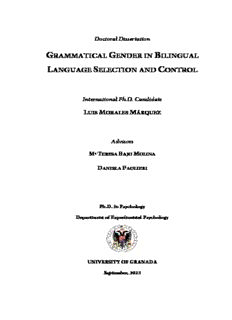Table Of ContentDoctoral Dissertation
GRAMMATICAL GENDER IN BILINGUAL
LANGUAGE SELECTION AND CONTROL
International Ph.D. Candidate
LUIS MORALES MÁRQUEZ
Advisors
Mª TERESA BAJO MOLINA
DANIELA PAOLIERI
Ph.D. in Psychology
Department of Experimental Psychology
UNIVERSITY OF GRANADA
September, 2013
Editor: Editorial de la Universidad de Granada
Autor: Luis Morales Márquez
D.L.: GR 627-2014
ISBN: 978-84-9028-853-5
UNIVERSIDAD DE GRANADA
DPTO. DE PSICOLOGÍA EXPERIMENTAL
Campus Universitario de Cartuja, s/n
Tfno. +34 958 24 37 63 – Fax +34 958 24 62 39
18071 – GRANADA – ESPAÑA
Tesis doctoral presentada por Luis Morales Márquez, en el
Departamento de Psicología Experimental, para aspirar al
grado de Doctor Internacional en el programa de Doctorado
de Psicología de la Universidad de Granada.
El doctorando, Luis Morales Márquez, y los directores de la tesis,
Mª Teresa Bajo Molina y Daniela Paolieri, garantizamos, al
firmar esta tesis doctoral, que el trabajo ha sido realizado por el
doctorando bajo la dirección de los directores de la tesis y hasta
donde nuestro conocimiento alcanza, en la realización del
trabajo, se han respetado los derechos de otros autores a ser
citados, cuando se han utilizado sus resultados o publicaciones.
Firmado en Granada, a 2 de septiembre de 2013.
Directores de la tesis: Doctorando:
Mª Teresa Bajo Daniela Paolieri Luis Morales
I am sincerely grateful to my two PhD advisors, Teresa and Daniela,
for their invaluable guidance and their great deal of support.
Warmest thanks go to my parents and brother for being the most
supporting and loving family anyone can wish for.
The last words of gratitude are for Julia, for being by my side always, and
for María and Mariagrazia, for their strong friendship and affection.
Introductory Note
The content of this doctoral dissertation has been drawn up
according to the regulations of the University of Granada to
obtain the International Doctorate Mention in the Psychology
Doctoral Program. According to this, the majority of the thesis
has been written in English. Specifically, in Chapter I a
theoretical introduction to the subject of the investigation is
presented in Spanish. Next, Chapter II contains a summary of the
theoretical background written in English. Finally, the rest of the
empirical chapters (Chapters III to VI) and the general
discussion (Chapter VII) proceeds in English.
This thesis aims to explore important aspects of lexical access in
monolingual and bilingual speakers through the study of
grammatical gender in Romance languages. After reviewing
previous empirical data and theoretical approaches in the
introductory chapters, in Chapter III we present evidence of how
grammatical gender is represented and accessed within the lexical
system in Spanish and Italian speakers. This is the basis for
studying the interaction of the languages at this level in Italian-
Spanish bilinguals. Thus, in Chapter IV we show that
grammatical gender influences bilingual lexical access in
gendered languages and leads to between-language competition
in L2 spoken-word processing. Then, in Chapter V we explore
the transfer of grammatical gender properties from a gendered
language (Spanish) to a second language lacking this feature
(English); and additionally we evidence that being immersed in
an L2 context prevents the influence of the native language at this
level. This result parallels the idea that bilinguals must inhibit
their L1 to facilitate L2 access. Therefore, in Chapter VI we
explore whether Italian-Spanish speakers can inhibit the
grammatical gender of their native language while performing a
task in L2 and it is a source of competition between languages.
Finally, some of the more interesting points which emerge from
our studies are considered fully in the general discussion in
Chapter VII.
CAP. I. INTRODUCCIÓN Y OBJETIVOS DE LA TESIS .......................... 1
Acceso Léxico en la Producción Lingüística ....................................... 4
El Género Gramatical en la Producción Lingüística Monolingüe ... 9
Acceso Léxico en Bilingües ................................................................. 23
El Género Gramatical en la Producción Lingüística Bilingüe ........ 31
Selección de Idiomas en Bilingües ...................................................... 42
Organización y Objetivos de la Serie Experimental ......................... 53
Referencias ............................................................................................. 55
CH. II. INTRODUCTION AND AIMS OF THE THESIS ........................ 69
Lexical Access in Monolingual Speakers ........................................... 71
Grammatical Gender and Language Production in Monolinguals ..... 75
Grammatical Gender and Language Production in Bilinguals ...... 83
Language Selection Mechanisms in Bilinguals ................................. 93
Aims and Organization of the Experimental Section ...................... 98
References ............................................................................................ 100
CH. III. EXPERIMENTS 1 AND 2 .................................................... 113
Experiment 1 ....................................................................................... 117
Method ...................................................................................................... 118
Results and Discussion ............................................................................ 120
Experiment 2 ....................................................................................... 123
Method ...................................................................................................... 123
Results and Discussion ............................................................................ 124
General Discussion ............................................................................. 125
References ............................................................................................ 128
CH. IV. EXPERIMENTS 3, 4 AND 5 ................................................. 133
Experiment 3 ....................................................................................... 140
Method ...................................................................................................... 140
Results and Discussion ............................................................................ 145
Experiment 4 ....................................................................................... 150
Description:grammatical gender is represented and accessed within the lexical system in Grammatical Gender and Language Production in Bilinguals 83 tamburo (drum) m. cavallo (horse) pistola (gun) martello (hammer) m. carciofo (artichoke) cicogna (stork) treno (train) m. casco (helmet) rosa (rose).

